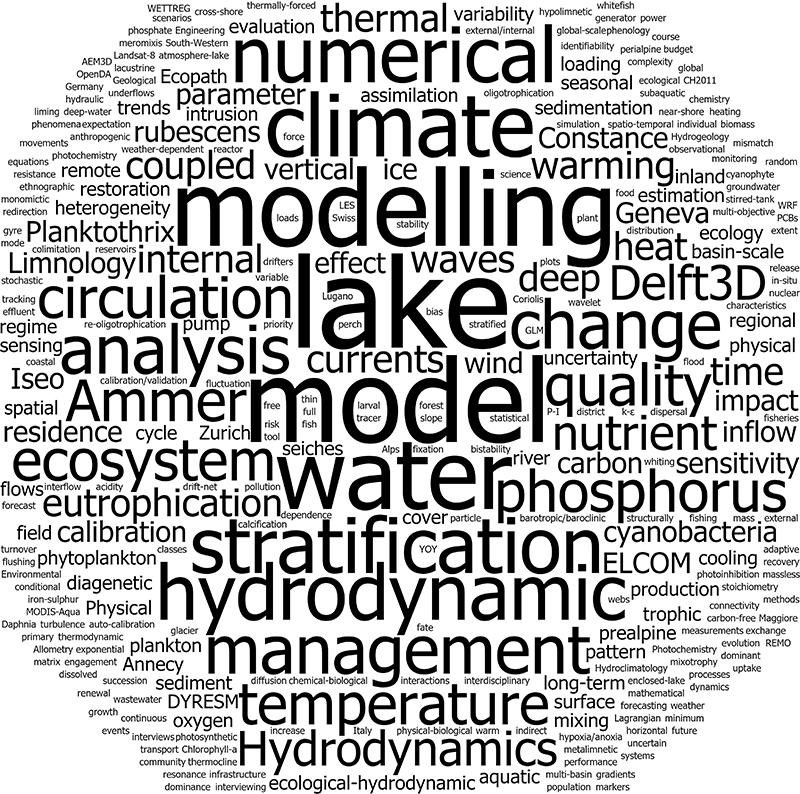Modelling physical and ecological processes in medium-to-large deep European perialpine lakes: a review

Accepted: 5 October 2021
HTML: 124
All claims expressed in this article are solely those of the authors and do not necessarily represent those of their affiliated organizations, or those of the publisher, the editors and the reviewers. Any product that may be evaluated in this article or claim that may be made by its manufacturer is not guaranteed or endorsed by the publisher.
Authors
In this paper we review a significant sample of the modelling studies carried out on medium-to-large deep European perialpine lakes (MLDEPLs). The reviewed bibliographic corpus was obtained querying Elsevier’s Scopus® database with a tailored search string on 8 January 2021. Results were filtered, accepting only journal papers written in English dealing with natural lakes having surface area > 10 km2. A list of 75 works was obtained, published between 1986 and 2021. Most studies have been carried out on Swiss lakes (44 out of 75 papers), Lake Geneva being the most investigated environment. A significant positive correlation was found between lake surface area and volume and the number of dedicated papers, suggesting that scientific attention is higher for environments characterised by large dimensions and relevant socio-economic interests. Both the number of papers and their citation count have experienced an exponential growth in time, pointing to a rising interest in quantitative modelling applications, but also to the increasing availability and ease of use of numerical modelling tools. Among the 75 selected papers, 55 employ a hydrodynamic driver, used alone or coupled with an ecological module, while the remnant 20 works adopt an ecological-only model. Among the papers employing hydrodynamic models, the use of three-dimensional (3D) drivers is surprisingly slightly more frequent (28 papers) than that of one-dimensional (1D) ones (26 papers), with most 3D applications having been published in the last 2011-2020 decade (24 papers). This reflects the interest on the hydrodynamic processes leading to the observed spatial heterogeneities in the biochemical properties of the MLDEPLs. However, coupling of ecological modules with 3D hydrodynamic drivers, to directly simulate these phenomena, is still restricted (2 papers) compared to that of 1D hydrodynamic drivers (8 papers), due to calibration and computational difficulties, which could be strongly reduced by future research achievements. Nevertheless, 1D models allow performing long-term prognoses considering multiple climate change and watershed management scenarios, due to their much smaller computational burden. The largest group of works dealing with ecological-only models (6 papers) is dedicated to applications of phosphorus budget models, which can above all be used to forecast variations in lake productivity in response to changes in the availability of the limiting nutrient.
Graphical abstract
How to Cite

This work is licensed under a Creative Commons Attribution-NonCommercial 4.0 International License.
Similar Articles
- Jianming Deng, Yunlin Zhang, Boqiang Qin, Xiaolong Yao, Yubing Deng, Trends of publications related to climate change and lake research from 1991 to 2015 , Journal of Limnology: Vol. 76 No. 3 (2017)
- Muhammed Shikhani, Chenxi Mi, Artur Gevorgyan, Gor Gevorgyan, Amalya Misakyan, Levon Azizyan, Klemens Barfus, Martin Schulze, Tom Shatwell, Karsten Rinke, Simulating thermal dynamics of the largest lake in the Caucasus region: The mountain Lake Sevan , Journal of Limnology: Vol. 81 No. s1 (2022): Lake Sevan. Past, present, and future state of a unique alpine lake
- Stefan Weinberger, Mark Vetter, Lake heat content and stability variation due to climate change: coupled regional climate model (REMO)-lake model (DYRESM) analysis , Journal of Limnology: Vol. 73 No. 1 (2014)
- Jordi Prats, Marie-José Salençon, Magali Gant, Pierre-Alain Danis, Simulation of the hydrodynamic behaviour of a Mediterranean reservoir under different climate change and management scenarios , Journal of Limnology: Vol. 77 No. 1 (2018)
- Csaba Vadadi-Fülöp, Levente Hufnagel, Climate change and plankton phenology in freshwater: current trends and future commitments , Journal of Limnology: Vol. 73 No. 1 (2014)
- Neal Michelutti, Jillian L. Lemmen, Colin A. Cooke, William O. Hobbs, Alexander P. Wolfe, Joshua Kurek, John P. Smol, Assessing the effects of climate and volcanism on diatom and chironomid assemblages in an Andean lake near Quito, Ecuador , Journal of Limnology: Vol. 75 No. 2 (2016)
- Walter Finsinger, Thierry Fonville, Emiliya Kirilova, Andrea Lami, Piero Guilizzoni, André F. Lotter, A long-term multi-proxy record of varved sediments highlights climate-induced mixing-regime shift in a large hard-water lake ~5000 years ago , Journal of Limnology: Vol. 73 No. 2 (2014)
- Iván Hernández-Almeida, Martin Grosjean, Sergi Pla-Rabes, Janusz Filipiak, Alicja Bonk, Wojciech Tylmann, Influence of inter-annual environmental variability on chrysophyte cyst assemblages: insight from a 2-years sediment trap study in lakes from northern Poland , Journal of Limnology: Vol. 76 No. 2 (2017)
- Piero Guilizzoni, Suzanne N. Levine, Marina Manca, Aldo Marchetto, Andrea Lami, Walter Ambrosetti, Achim Brauer, Stefano Gerli, Elisabetta A. Carrara, Angelo Rolla, Licia Guzzella, Davide A.L. Vignati, Ecological effects of multiple stressors on a deep lake (Lago Maggiore, Italy) integrating neo and palaeolimnological approaches , Journal of Limnology: Vol. 71 No. 1 (2012)
- Tomasz Mieczan, Urszula Bronowicka-Mielniczuk, Ciliates in different types of pools in temperate, tropical, and polar climate zones – implications for climate change , Journal of Limnology: Vol. 81 (2022)
You may also start an advanced similarity search for this article.
-
Andrea Fenocchi, Nicolò Pella, Diego Copetti, Fabio Buzzi, Daniele Magni, Nico Salmaso, Claudia DrestiJournal of Contaminant Hydrology : 2025
-
Paolo Dezuanni, Diego Copetti, Claudia Dresti, Nicolò Pella, Fabio Buzzi, Andrea FenocchiFrontiers in Environmental Science : 2025
-
Laura M. V. Soares, Olivia Desgué‐Itier, Cécilia Barouillet, Céline Casenave, Isabelle Domaizon, Victor Frossard, Nelson G. Hairston, Andrea Lami, Bruno J. Lemaire, Georges‐Marie Saulnier, Frédéric Soulignac, Brigitte Vinçon‐Leite, Jean‐Philippe JennyLimnology and Oceanography Letters : 2025
-
Diego CopettiResources : 2023
-
Andrea Fenocchi, Fabio Buzzi, Claudia Dresti, Diego CopettiEcological Indicators : 2023
-
L.M.V. Soares, M. Thouillot, V. Frossard, O. Desgué-Itier, C. Barouillet, Y. Baulaz, J.-C. Clément, I. Domaizon, J.-M. Dorioz, C. Goulon, J. Guillard, S. Jacquet, E. Réalis, V. Tran Khac, J.-P. JennyEcological Indicators : 2025

 https://doi.org/10.4081/jlimnol.2021.2041
https://doi.org/10.4081/jlimnol.2021.2041





